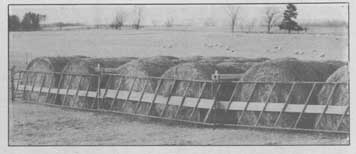
Instead of feeding individual bales separately with a tractor, why not eliminate the chore work -- and the need for starting up the tractor -- by strategically arranging the bales in rows so livestock can feed themselves?
"I wouldn't do it any other way," says Wisconsin farmer and school teacher James Schultz, of Clintonville. He teamed up with his veterinarian, Dr. Robert Leder, of Bear Creek, to design a self-feeding system for sheep that won first place in "The 1991 Inventions Contest," sponsored by Sheep Magazine, published in Helenville, Wis.
Although their experience has been only with sheep, the inventors are confident the same basic design could easily be "beefed up" to adapt it for beef or dairy animals. "It's inexpensive to build, cuts down on labor, eliminates the need for a chore tractor, and there's virtually no waste," says Schultz of the self-feeding system. Here's how it works:
When bringing big round bales to headquarters, or wherever you want to locate one or more self-feeding stations, you line them up face to face tight against each other, and in rows spaced 1 ft. apart.
Self-feeding panels, made or wood or steel, are 12 ft. wide. Each panel spans two bale rows, For sheep, Schultz drives steel T-posts 12 ft. apart between every two rows. The posts support 12 ft. long 2 by 4's, suspended horizontally about 3 1/2 ft. above ground and secured to the steel support posts. The horizontal 2 by 4's serve as runners which guide and support each end of each panel. The bottom of each panel is suspended 8 to 10 in. off the ground, making it easy for animals to nudge the feeding panels forward as they eat their way into the bales. Panel ends are tied to the horizontal 2 by 4 supports with chains equipped with snaps, making it easy to undo the chains to lift them up and over each T-post as the panels gradually move from one post to the next.
Suppose you create a feeding station 10 bales wide, with 20 bales in each row. You would need five feeding panels (one for every two rows). Before frost sets in, you would set posts 12 ft. apart between each pair of rows. As animals eat their way into the bales and move the panels forward, the horizontal 12 ft. long 2 by 4's can be "walked back" from post to post in 12-ft. intervals. Thus, in this example, you'd need six 12-ft. long 2 by 4's to serve as horizontal support runners for the five side by side panels.
The feeding station can be as wide and long as you want it. But be sure all of the bales are of comparable quality and palatability to assure a uniform front "feeding face" as animals move the panels forward.
For aged ewes, Schultz suggests having one feeding stall for every two animals. The 12-ft. wide panels can be handmade of wood or tubular steel, or purchased ready made, which is what Schultz did. He bought cattle feeding panels, then boarded them up part way so sheep couldn't walk through the openings. Dr. Leder built the panels he uses out of lumber, using 1 by 4's for the vertical dividers.
Schultz recommends using snow fence, or chain link fence, along the sides and back side of the feeding station so animals can't get at the bales. "If there's snow and ice between the bales, you may have to periodically chip it away to make sure the panels move ahead unobstructed."
